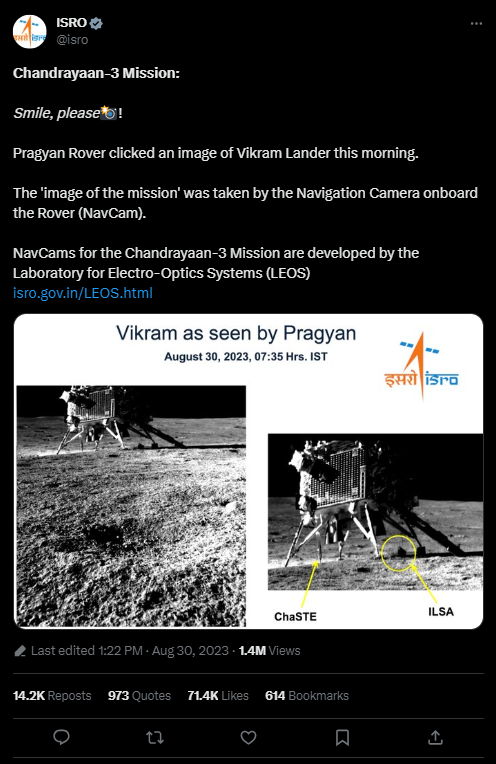Chandrayaan 3: A week after the successful soft-landing of the Moon Mission that propelled India to record heights in space science, Chandrayaan 3 sent the first image of the Vikram lander taken by the Pragyan rover. The Pragyan rover’s navigation camera captured the picture. The photo was shot on Wednesday at 7.35 am (Indian time), according to Isro. The Vikram lander is seen in the picture, which was taken on the moon. According to the space agency, two of its payloads, ChaSTE and ILSA, can be seen in the image.
Chandrayaan 2 Satellite Captures Vikram Lander on Moon’s South Pole

Prior to being removed, Isro released a picture of the Vikram lander captured from the Chandrayaan 2 satellite. The Vikram lander in the south pole of the moon was captured in this first image. Following the successful soft landing last week, Isro published numerous images of the Pragyan rover leaving Vikram and then ambling around. The Shiv Shakti Point, where the Vikram lander landed, can now be expected to remain stationary for the first time.
Chandrayaan 3’s Vikram Lander Successfully Lands on Moon’s South Pole
The Chandrayaan 3 lander named Vikram made a smooth landing on the south pole of the moon while carrying the Pragyan rover inside of it. Chandrayaan 3 waited for the lunar dust to settle after the landing before the Pragyan rover began operating. It first rolled out of the lander and began strolling across the moon. Chandrayaan 3’s discoveries about the moon over the past week have all been firsts of their sort because no other spacecraft has ever landed on the moon’s south pole before Chandrayaan 3. The Vikram lander is equipped with four payloads: LRA to study the dynamics of the lunar system, ILSA to detect the seismicity near the landing site, ChaSTE to test the thermal characteristics of the soil, and RAMBHA to measure the near-surface plasma density.
Vikram Lander’s ChaSTE Payload Discovers Varied Moon Soil Temperatures
The moon’s soil temperature was examined by the Vikram lander’s payload ChaSTE, which found a wide range of temperatures from minus 10 degrees Celsius to 60-70 degrees Celsius from minus 80 millimetres below the surface to 20 millimetres above the surface, respectively. Rover After rolling away from the Vikram lander, Pragyan began its experiments. As instructed by Isro, it went for a stroll and altered its course when it noticed a crater in front of it. The elements that are present at the south pole of the moon, according to Pragyan’s study of them, include sulphur, oxygen, aluminium, calcium, etc. Pragyan sent a picture of Vikram on Wednesday.
Keep watching our YouTube Channel ‘DNP INDIA’. Also, please subscribe and follow us on FACEBOOK, INSTAGRAM, and TWITTER.